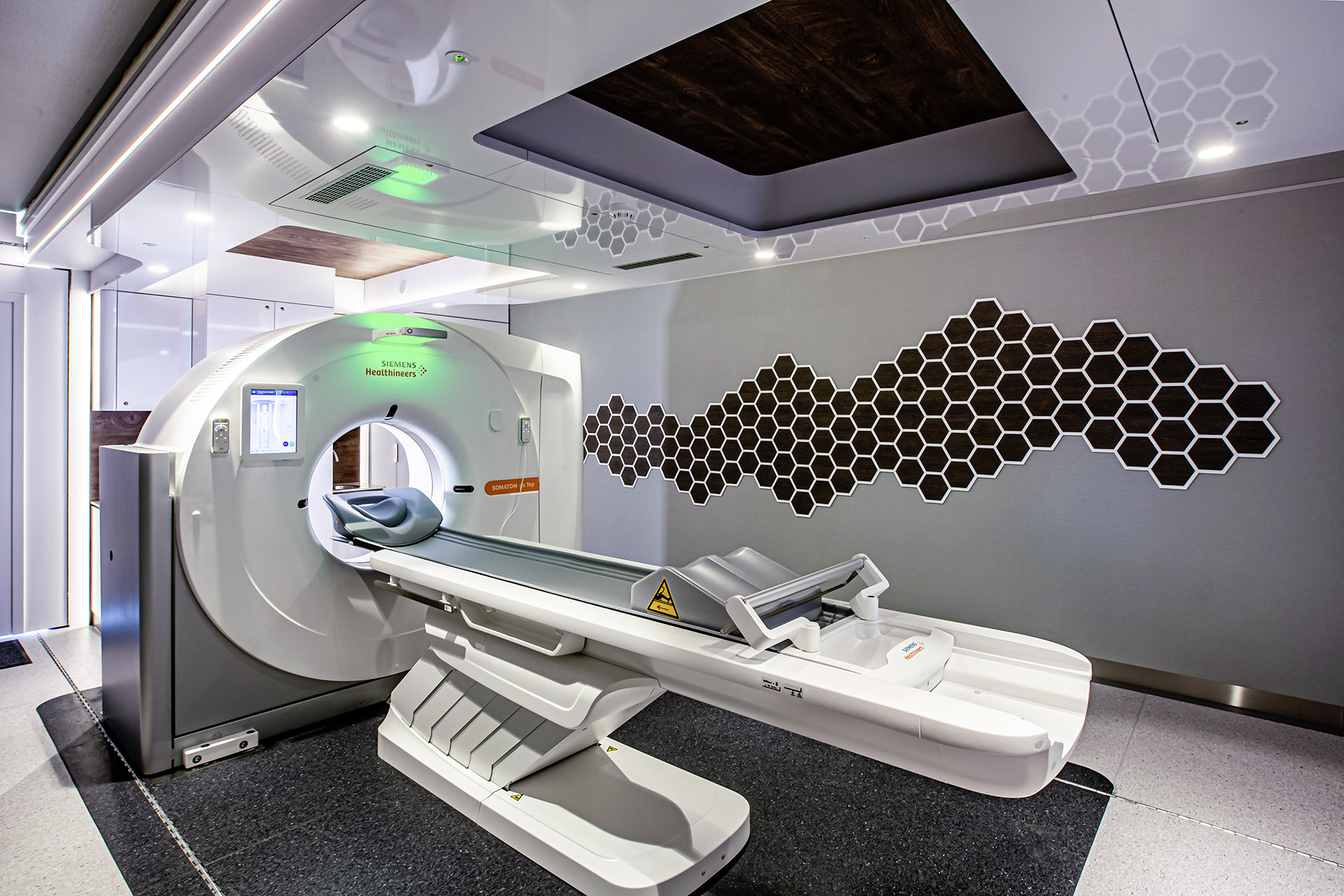HANSE study: "There has never been a project of this magnitude before”
Published: 06.12.2023
90 percent of all lung cancer patients are smokers or have smoked. With the help of lung cancer screening, lung diseases can be detected at an early stage. The HANSE study offered a free check-up starting July 2021. Read this article from 2021, where radiologist and lead investigator Jens Vogel-Claussen told us more.
Starting July 2021, a mobile study truck travelled between Hanover, Lübeck and Großhansdorf near Hamburg. As part of the HANSE study, smokers and former smokers had the opportunity to participate in a free lung cancer screening. Prof. Dr. med. Jens Vogel-Claussen, radiologist and investigator at the Hannover Medical University, is leading the project.

(Photo: Stefan Knaak Photography)
Prof. Vogel-Claussen, from July 2021 the HANSE study will be offering a free lung check in the northern German region. Why is early detection of lung diseases such as lung cancer so important?
"Lung cancer is one of the most common malignant diseases worldwide. In Germany, there are over 50,000 cases per year. The chance of survival for those affected is only about 15 to 20 percent five years after the disease is diagnosed - often because the cancer is discovered very late."
Latest White Paper
Who is the study aimed at?
"Smokers and people who have smoked make up 90 percent of lung cancer patients. In addition, the cancer often appears in older people. Therefore, the study is aimed at former smokers and non-smokers between the ages of 55 and 79. In an initial questionnaire, we collect information on how long and how much they smoke or when they stopped. We calculate the likelihood of the subjects developing lung cancer within the next six years using a model. Those who exceed a certain threshold are invited to a lung cancer screening."
And what happens to the people who do not exceed this threshold?
"We also stay in touch with the subjects in the low-risk group who are not invited for screening. Five years later, we ask about their health status and whether they have received a cancer diagnosis. Lung cancer develops very slowly, as part of our study we also want to check whether we are being too selective and end up missing cancer cases in the age group."
As part of the study, the lung function of the participants is examined by means of computed tomography. What are the advantages of CT scans compared to other diagnostic procedures?
"While X-rays only produce a one-dimensional image, low-dose CT is a three-dimensional procedure that provides hundreds of images that we can superimpose. This means that lung cancer can be detected in the early stages when it measures significantly less than three centimetres. The earlier the cancer is detected, the better the chances of recovery for patients. In other countries where the procedure is already established, the mortality rate for lung cancer has been reduced. This result shows: Lung cancer screening works."

(Photo: Stefan Knaak Photography)
The HANSE study focuses not only on lung diseases, but also on cardiovascular diseases. Why?
"Studies show that there are major overlaps between the development of lung cancer and coronary heart disease in smokers. Almost 50 percent of these subjects had coronary calcification, which means they suffer from atherosclerosis. In the worst case, the consequences can be a heart attack or stroke.
For this reason, we also measure the calcium level in the coronary vessels, the arteries that supply the heart muscle with blood, during the CT scan. In case of positive findings, we recommend a cardiac check-up with the treating general practitioner or cardiologist. We also ask whether the subject has followed our recommendation after one year."
The data from the CT scan is evaluated using artificial intelligence. How does the AI work?
"We use state-of-the-art software to evaluate the data, which compares between 500 and 600 high-resolution images after the CT screening. There are many nodules in a person's lungs that are benign. The AI software recognises the lung, segments it and the lung nodules in the lobes. The software evaluates the volumetry and the size of the nodules and calculates whether they are more benign or malignant. The radiologist then looks at the results, and at the same time checks whether the computer has missed a nodule.
Many of these nodules would be difficult to see with the naked eye, so the radiologist saves a lot of time. In addition to the nodules and calcium score, the AI also collects the study participant's emphysema value. This indicates the extent to which the lung tissue has been destroyed."
With some study participants, all values are discussed, others only receive partial results. What do you hope to achieve from this?
"We are also interested in how people react to their values and the different information. What effect does the notification of the calcium value have on their heart care? Who participates in a smoke-free programme after the CT scan? Previous studies showed that only 15 percent of all participants in a lung cancer screening programme stopped smoking. In the Hanse study, we want to see if the smoke-free rate can be improved by providing information about the degree of lung tissue destruction in the participant's CT findings."
The HANSE study is considered a pilot project: participants are examined at three locations. How does that work?
"With our study, we want to collect data from 5000 subjects at three locations, Hanover, Großhansdorf and Lübeck, within one year. For this, we need a high-quality and interdisciplinary screening. We can do this with the truck, which is the heart of our infrastructure.
The entire technology of the study is located in this truck, which rotates between the locations every two weeks. This ensures that all study participants are examined with the same CT technology. We use a highly modern CT, whose radiation is very low, only between one fifth and one tenth of the annual exposure."
What logistical and technical challenges do you have to overcome for the project?
"This is the first study in Germany to use a truck for lung cancer screening. There has never been a project of this magnitude and with this workflow before. The challenges lie in the preparation of the study: the technology of the truck, the digital infrastructure with its many interfaces, the approaching of the subjects and the training of the staff, radiologists, pneumologists and study nurses, who carry out the screening on site and work together interdisciplinary.
Meanwhile, the right equipment is needed for processing the data: all values run into a common cloud so that we can access the pseudonymised data and evaluate them interdisciplinary. All in all, this makes our project very innovativ."
What is the biggest opportunity of the project?
"With this study, we are demonstrating the diagnostic possibilities of lung screening. Lung cancers can be detected and treated much earlier using CT. This examination is not only efficient, but also very gentle for patients due to the low radiation exposure. If CT screening of the lung were to be included as a service in preventive medical care, like other diagnostic procedures, we would diagnose more lung cancers at a very early stage and reduce the associated mortality rate. In addition, the results from the CT scans can be used to develop further steps for heart diagnostics and screening.
The project also highlights the significance of having the right infrastructure for digital studies: secure cloud computing and IT systems that ensure efficient data processing and protection are of utmost importance. CROs like Alcedis, who provide this infrastructure, must fulfil their tasks perfectly and will become increasingly important in the future. Their expertise and planning are key to making future studies both efficient and secure."


